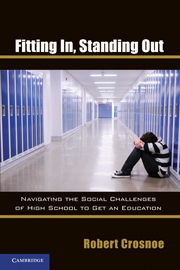Book contents
- Frontmatter
- Contents
- Acknowledgments
- PART I HIGH SCHOOLS AS CONTEXTS OF DEVELOPMENT
- PART II A CASE STUDY OF SOCIAL AND ACADEMIC EXPERIENCES IN HIGH SCHOOL
- 5 The Stakes of Social Marginalization
- 6 Teenagers at Particular Risk
- 7 How Teenagers Know What They Know and Why It Matters
- 8 Sources of Resilience
- PART III HELPING TEENAGERS NAVIGATE HIGH SCHOOL
- Works Cited
- Index
5 - The Stakes of Social Marginalization
Published online by Cambridge University Press: 05 June 2012
- Frontmatter
- Contents
- Acknowledgments
- PART I HIGH SCHOOLS AS CONTEXTS OF DEVELOPMENT
- PART II A CASE STUDY OF SOCIAL AND ACADEMIC EXPERIENCES IN HIGH SCHOOL
- 5 The Stakes of Social Marginalization
- 6 Teenagers at Particular Risk
- 7 How Teenagers Know What They Know and Why It Matters
- 8 Sources of Resilience
- PART III HELPING TEENAGERS NAVIGATE HIGH SCHOOL
- Works Cited
- Index
Summary
Based on the integrative model put forward in Chapter 3 and its elaboration in Chapter 4, we have a general picture from past research about how teenagers' social experiences in high school can filter into their academic experiences. This general picture, in turn, can be mined for various action/intervention strategies by looking at it in different ways.
First, this general picture can be approached by contextualizing it within major macrolevel trends that converge in the current historical moment. Doing so emphasizes the need to understand 1) how social problems in high school are intensified by the new media and by the increasingly impersonal, institutional qualities of schools, 2) how the academic consequences of such social problems extend beyond traditional indicators of academic performance, like grades, to encompass the pathways that young people take through complex, differentiated curricula, and 3) how these academic problems during high school forecast post–high school prospects, thereby allowing the risks of high school social experiences to filter across the life course.
Second, this general picture can be approached by shifting attention away from the “good crowd versus bad crowd” dichotomy and toward the process of social adaptation to high school peer cultures more generally. Much has been written about this crowd dichotomy and its relation to teenagers' academic performance, and it is well understood. What is less understood are the academic risks associated with teenagers' social struggles to be accepted by their peers in high school, struggles that occur no matter how academically rigorous or lax a school is, no matter how scholastically focused or dismissive its student body is or its various subcultures are.
- Type
- Chapter
- Information
- Fitting In, Standing OutNavigating the Social Challenges of High School to Get an Education, pp. 83 - 113Publisher: Cambridge University PressPrint publication year: 2011



